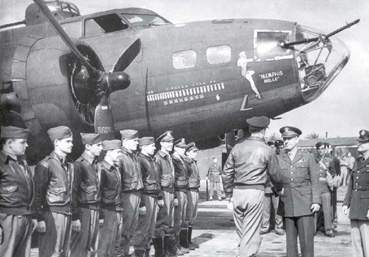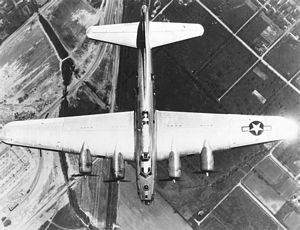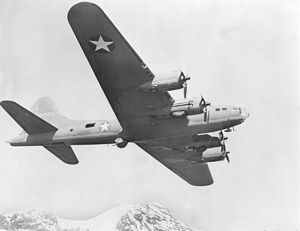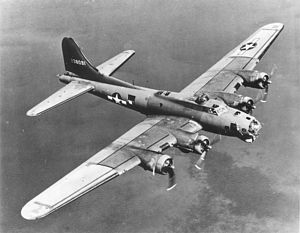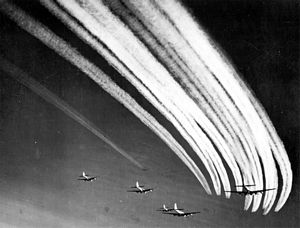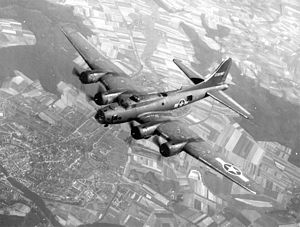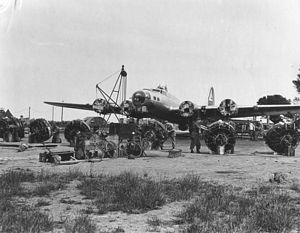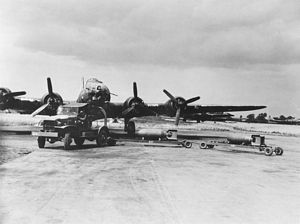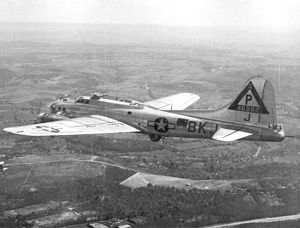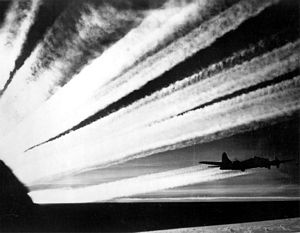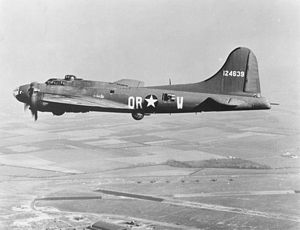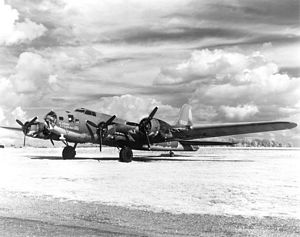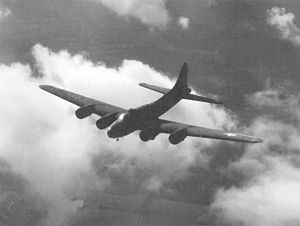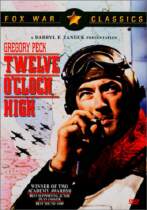Boeing B-17 Flying Fortress
12,700 planes produced, entered service 1939
B-17F specs: top speed 295 MPH, 17,600 lb. bombload, twelve .50 caliber machine guns
By Stephen Sherman, July 2002. Updated January 21, 2012.
In 1934, the Army issued specs for a "multi" engine bomber, which Boeing interpreted as four engines. While the Martin B-10 bomber seemed adequate at the time to defend the continental United States, with great foresight Boeing designed an altogether heavier, faster, higher-flying, and longer-range bomber, which proved to be invaluable in the strategic air battles over Germany.
Boeing started design work on its Model 299 in June, 1934; just over a year later the first flight of the prototype took place at Boeing Field, July 28, 1935. A month later, the shiny silvery aircraft flew to Wright Field, Ohio in record time, but crashed disastrously at its USAAC evaluation flight in October. Despite this accident, which was traced to human error - not a design flaw, the Air Corps recognized the potential of the Model 299 (aka XB-17), and orderd thirteen service-test models (Y1B-17) for evaluation. Among the notable changes incorporated into the Y1B-17, 930-hp Wright Cyclones replaced the original 750-hp Pratt & Whitneys (a change which lost 70,000 engine orders for the East Hartford company).
In the 1930's, the nation's military leaders debated bomber doctrine strenuously. Among the most influential views were those of Billy Mitchell and his bomber advocates. For them, the B-17 was a godsend - the manufactured, tangible embodiment of a "Flying Fortress."
As early as 1937, the 2nd Bombardment Group was equipped with B-17s, using them to perfect techniques of high-altitude, long-distance bombing. Since the only foreseeable use of such a capability was the defense of the nation's shores from enemy fleets, the U.S. Navy fiercely opposed the Army's development of the four-engine bomber. By way of a compromise the Army ordered 39 more B-17B's. The Air Corps' air doctrine envisioned large formations of fast, high-flying B-17 bombers, defending themselves against enemy fighters with their own massed machine-gun fire. Fighter escort was considered impractical, and even undesirable by the bomber advocates. In a way, any admission that fighter escort was necessary would imply that enemy fighters posed a real threat and that the Flying Fortresses were not invulnerable.
More improvements followed in the B-17C: more machine guns, self-sealing fuel tanks, more armor plating, up-rated engines, etc.. Even though all these increased the weight of the "C" model to 49,650 pounds, the installation of the 1,200 Wright Cyclones made the "C" capable of 320 MPH, the fastest of all B-17 variants.
B-17D
This was a slightly modified B-17C, with different engine cowling flaps and an extra pair of machine guns, bringing its total armament to six .50 caliber and one .30 caliber machine guns. While only 42 model "D"s were built, by the time of Pearl Harbor the existing "C" models had been upgraded to "D" specifications.
The first B-17D flew on February 3, 1941. Most were sent to Hawaii and the Philippines.
B-17E
The "E" model introduced some significant changes from the earlier versions, the most visible being the addition of a dorsal fin forward of the now-larger tail, greatly thickening the profile view of "E" and later versions when compared to earlier models. These features increased flight stability, especially during high-altitude bomb runs.
Equally significant was the addition of a pair of .50 caliber machine guns in a tail turret, resolving a deficiency that had been noted by August, 1940 when the B-17E was ordered. The addition of the tail turret required a completely redesigned rear fuselage, resulting in a six foot longer aircraft. The third big change was the installation of powered turrets in the ventral and dorsal positions.
Crew: pilot, copilot, bombardier, navigator, flight engineer, radio operator, tail gunner, belly gunner, and two waist gunners. The navigator or bombardier used the nose gun, and the flight engineer operated the dorsal turret
With the same 1200 hp engines, these add-ons made for a somewhat slower, but eminently more defensible, B-17E. It's specs were similar to the B-17D, noted above, but the overall length was 74 feet, and it carried nine machine guns (eight .50's and one .30). Boeing produced 512 "E"s.
B-17F
The "F" was the first B-17 variant to be produced by all of the "B.V.D." companies (Boeing, Lockheed/Vega, and Douglas). Because of the pressing demand for the Flying Fortress, Boeing provided blueprints and cooperation for the B-17 to be built at the Douglas plant in Long Beach and the Vega plant in Burbank. Altogether, they would turn out 3405 B-17Fs: 2300 by Boeing, 605 by Douglas, and 500 by Lockheed/Vega. The first B-17F flew in May, 1942.
From the outside, the "F" closely resembled the "E;" only the unframed, bubble-style plexiglass nose appeared different. Internally, over 400 changes made the B-17F a better bomber: new Wright R-1820-97 Cyclone engines (capable of 1380 hp in short bursts), paddle-bladed propellers, a stronger undercarriage, external bomb racks, better brakes, carburetor intake filters, etc..
B-17F's participated in the January 27, 1943 raid on Wilhelmshaven, the first USAAF mission over Germany. The Luftwaffe pilots quickly identified the B-17's vulnerability to head-on attack. Field modifications, typically jury-rigged machine guns, didn't help much. The stage was set for the B-17G, the definitive variant of the Flying Fortress.
 - More pictures of B-17s and other bombers at Photo Gallery 2.
- More pictures of B-17s and other bombers at Photo Gallery 2.
B-17G
This version fairly bristled with defensive firepower: 13 Browning .50 caliber machine guns. Chin, dorsal, ventral, and tail turrets each mounted a pair of guns (8). Left- and right- side guns in the cheeks and waist added 4 more. And a single, rear-firing gun on the top of the fuselage made 13. No wonder Luftwaffe pilots suffered from "vier motor schreck" ("four-engine fear").
The most distinctive change was the "chin" turret, sticking out below the nose. It looks like an after-thought, and it was. But the two machine guns there addressed the B-17's earlier vulnerability.
With 8,680 produced between July 1943 and April 1945, the "G" was the most numerous B-17 variant: 4,035 B-17Gs by Boeing, 2,395 by Douglas, and 2,250 by Lockheed/Vega. The vast majority of surviving B-17s are "G"s.
In the Pacific
Before the United States got into the war, we stationed most of our 150 B-17's (C, D, and a few E models) in the Pacific, in part hoping that their presence would serve as a deterrent to the Japanese. Thirty-five B-17s of the 19th Bombardment Group (BG) were stationed in the Philippines, 19 at Clark Field, Luzon and 16 at Del Monte, on Mindanao. Sixteen were in the Canal Zone. Twelve, of the 5th BG, were at Hickam Field, Hawaii. And, as every student of the attack on Pearl Harbor knows, six more B-17s were approaching Hickam Field on the morning of December 7th. They touched down wherever they could. In the Japanese attack that morning, five B-17s were destroyed and eight were damaged.
In the Philippines, an odd drama unfolded. The bombers at Clark Field were stationed there as a deterrent. Plans were in place for an immediate strike against Japanese bases on Formosa in the event of war. Generals MacArthur and Brereton got prompt word of the attack on Pearl Harbor. But the B-17's did not attack Formosa; they circled Luzon defensively, then returned to base. The next day, the Japanese struck Clark Field and destroyed or damaged all but one of them. A few damaged planes were repaired and joined up with the squadrons at Del Monte. These few B-17's launched some ineffectual attacks against the Japanese onslaught, including one mission in which the pilot, Colin Kelly, thought he had sunk the battleship Haruna. He died on landing, but won great acclaim and a DSC. Postwar research indicated that he had slightly damaged a cruiser.
Eventually 14 surviving B-17s from the Philippines evacuated to Batchelor Field near Darwin, Australia. From these early defeats in the Philippines and Java to the shoestring existence in Australia, maximum effort missions were lucky to involve six or ten B-17's. Crews lived in makeshift accommodations with swarms of insects, disease, poor food, and lack of spare parts. They battled furious tropical storms as much as the enemy and flew incredibly hazardous missions, often at night. B-17's were involved in the Solomons campaign and New Guinea; they were especially effective the Battle of the Bismarck Sea, using skip-bombing techniques against the Japanese transports.
In another example of the "fog of war," Army B-17's participated in the Battle of Midway, and again claimed great successes against the Japanese invasion ships (the B-17's original mission back in the mid Thirties). Again, they hadn't made much of an impact. As described in Gordon Prange's Miracle at Midway the Navy's dive bombers scored all the big hits.
In Europe
In a sense, the story of the B-17 in Europe IS the story of the air war over Europe. The strategic choices, the debates over daylight "precision" bombing vs. nighttime area bombing, the targeting of ball-bearing plants, oil production, & aircraft manufacturing, the staggering losses, etc. could fill volumes. Indeed the story of the air war in Europe HAS filled volumes. What follows here is very summary.
The Eighth Air Force (8AF) was organized in England in early 1942. Its mission - to destroy Germany's ability to wage war, through daylight bombing raids (complementing the RAF's nighttime attacks). Massed formations of Flying Fortresses would roam over Occupied Europe, wreaking havoc on the German war machine, while relying on the bombers' speed, altitude, and own firepower for protection. Billy Mitchell, "Boom" Trenchard, and Guilio Douhet were to be proven right at last!
The first B-17E arrived in Britain on July 1, 1942. Six weeks later, August 17, eighteen Flying Fortresses launched their first raid against Nazi Europe, hitting rail yards at Rouen. Eighth Air Force head General Ira Eaker went along on this mission, flying in Yankee Doodle; the Luftwaffe didn't come up that day. Light opposition continued for the next ten missions. While many B-17's were diverted to the North African front in the Fall of 1942, the remaining 8AF Bomb Groups targeted the submarine pens along the coast. It was an ineffective campaign; the thick concrete pans were difficult to damage and the many aircrew were lost. But learning, expensive as it was in "blood and treasure' continued. In January, the Eighth adopted the "bomb on the leader" approach, where all the B-17s in a flight dropped when the lead plane's bombardier dropped.
As the heavy bomber demands of the North African campaign eased in the winter of 1942-43, the air war in Northwest Europe accelerated. On January 27, 1943, for the first time, American bombers hit inside of Germany itself, the submarine facilities at Wilhelmshaven.
A turning point was reached on April 17, when 115 Flying Fortresses bombed the Focke-Wulfe factory in Bremen. As if defending its nest, the Luftwaffe struck hard, knocking down sixteen B-17's (a 15 percent loss rate - on a single mission!). Soon, ten-to-fifteen percent losses became the norm, as the Luftwaffe improved their tactics, in particular by attacking the B-17's head on. Thus the famous phrase "Bandits at twelve o'clock high!"
But the Eighth continued grimly on, throughout 1943, next targeting ball-bearing production, considered a vital weak point in aviation manufacturing. On the 17th of August, a large force of 376 bombers raided Schweinfurt and Regensburg. Sixty bombers, with six hundred aircrew, didn't come back. 16 percent losses. At that rate, the Eighth Air Force could not continue. When B-17G's began to arrive in August and September, the forward machine guns in their chin turrets helped a little. The appalling wastage continued:
- September 6 - Over 400 bombers attacked the Stuttgart ball-bearing plant; 45 were lost.
- October 14 - Schweinfurt again. 291 B-17's went out; 60 went down.
- January 11, 1944 - German aircraft industry targets. 600 Flying Fortresses were sent out. Because of bad weather, only 238 reached Germany; 60 were shot down.
German industrial capacity proved remarkably resilient. Armaments Minister Albert Speer mobilized German (and captive) labor and decentralized critical production. In his Inside the Third Reich: Memoirs, Speer told of his efforts "After the second heavy raid on Schweinfurt on October 14, 1943, we again decided to decentralize. Some of the facilities were to be distributed among the surrounding villages, others placed in small, as yet unendangered towns in eastern Germany. This policy of dispersal was meant to provide for the future; but the plan encountered ... resistance on all side. The Gauleiters did not want new factories in their districts for fear that the peacetime quiet of their small towns would be disturbed."
In late 1943, P-38's and P-47's began to provide the long range escort that the 'Forts' needed. But the ultimate answer, the P-51 Mustang, which could reach Berlin, only appeared in March, 1944.
Big Week
In February, 1944, and especially in the third week, later dubbed "Big Week," the Eighth Air Force launched massive raids against German aircraft manufacturing in Leipzig, Augsburg, Regensburg, Schweinfurt, Stuttgart, etc.. Starting on the 20th, VIII Bomber Command launched over 1,000 Flying Fortresses in an attempt to destroy the Luftwaffe. American losses were heavy - 244 bombers and 33 fighters, but the Luftwaffe's strength never recovered. Its losses in the air were almost as damaging as the destruction of the factories.
The following month, March 1944, Mustangs escorted the B-17s all the way to Berlin. As Goering later said, when he saw Mustangs over Berlin, "he knew the jig was up." Because from that date, the bombers could range all over Germany, not immune from losses, but with fighter escort to keep Allied losses down and to continue to erode Luftwaffe strength. (While tangential to the B-17 story, Germany's inadequate pilot training and its short-sighted non-rotation of pilots made it impossible for the Luftwaffe to make good its losses, while competently trained American aircrew filled, replaced, and expanded the 8AF roster.)
In retrospect it seems that the Allies shifted the focus of their bombing too often. First submarines, then ball-bearings, the aircraft builders, then (in May, 1944) oil. Both Galland and Speer, in their memoirs, suggested that continued concentration on one of these industrial jugular veins might have yielded better results. Perhaps by May of 1944, the Allied analysts thought that enough damage had been done to the aircraft industry. They turned their attention to oil production, oil refineries, and synthetic oil plants.
457th Bomb Group
The 1944 experience of this typical group shows how relentless the USAAF bombing campaign was and how much the situation had changed since 1943 (when ten percent losses were the norm). The 457th BG arrived in ETO in February and for its first mission, participated in a "Big Week" raids on Gutersloh/Lippstadt, Oschersleben, Schweinfurt, and Augsburg. In four February missions, the 457th sent out 36, 18, 18, and 25 bombers, losing 4. In March, they flew 18 missions of 18+ planes each, hitting Berlin five times, and losing only 4 planes - about a one percent loss rate! Fifteen somewhat larger raids in April, typically with 24 planes, hit airfields and rail marshalling yards; the shift toward these tactical targets in anticipation of D-Day. Five B-17's of the Group didn't make it, for losses of 1.5 percent. In May - 19 raids of similar size, suffering two percent losses.
With D-Day in June, the 457th flew 23 missions, mostly against tactical targets, airfields, and marshalling in northern France. These missions included 800 sorties, with only nine planes lost. In the last five months of 1944, the 457th ran 87 missions, about 2700 sorties (540 per month), and lost 66 planes (13 per month), for a monthly loss ratio of 2.5 percent. Higher than earlier in the year, but far below the unbearable experience of 1943.
You can read more details about the 457th at the excellent 457th Bomb Group website.
Right up until May, 1945, the B-17 Flying Fortresses continued to batter the Third Reich. More than any other airplane, the big Boeing bombers brought the war to the Germans.
Experimental B-17's
As with most widely produced planes, the B-17 spawned a number of interesting variations. The YB-40, armed with additional machine guns and ammunition, was conceived as an escort fighter. But it was so heavy and so slow, that it couldn't keep up with the bombers. The B-17H was a post-war conversion of 12 (?) B-17G's into air-sea rescue planes, fitted with air-droppable life-rafts. Some of these (redesignated SB-17G) served in Korea and flew until the mid 1950's in the air-sea rescue role.
Rather less successful was the BQ-7, a conversion of some war-weary Forts into flying bombs. The planes were provided with radio-directed flight controls, packed with 10 tens of Torpex, and stripped of everything else. The pilot got the plane off the ground, headed toward the target, and he bailed out. On several attempts the BQ-7s either went out of control, exploding on English soil or the North Sea, or were hit by flak, or missed their targets.
Famous Planes
Memphis Belle
In mid-1943, the bomber crews of the Eighth Air Force were getting shot down at a very rapid rate. Morale reflected this. The promise of rotation home after twenty-five missions seemed too far away and too unlikely. "Who's gonna make twenty-five missions? We'll get shot down first."
A Flying Fortress of the 91st Bomb Group had racked up a lot of missions since its first on November 9, 1942. The pilot, Colonel Robert Morgan wrote of first mission jitters in his memoirs The Man Who Flew the Memphis Belle:
There was usually an interval of an hour, or an hour and a half, between the briefing and taxi time. On this first morning, the crew of the Memphis Belle did what we’d do on each of our succeeding missions. We gathered quietly and ran down the list of each of our duties. It was all low-key and professional. These young men around me, these working-class guys from several corners of America, who liked to drink beer and play cards and flirt with girls - suddenly they had the solemnity and the level gazes of men twice their age. It wasn’t fear, although we were all a little anxious. It was ten minds coming into acute focus.At the last minute before takeoff on that first mission, I rounded my crew into a huddle at the base of the Belle. We put our arms around one another, and I talked to them quietly for a couple of minutes.
I can’t recall the words I said. The important thing was that this was our huddle, our moment to come together among ourselves. To hear one another’s breathing, feel one another’s hands on our shoulders. To experience that instant when we stopped being ten separate entities, and became one.
At 10:22 a.m. a signal rocket from the Tower arced into the air and burst, and the 91st flew to France.
The best thing I can say about that first mission is that it was a valuable learning experience. We didn’t lose a single plane to the enemy, and we didn’t even suffer much damage. We only saw one Nazi fighter plane, and he was too far out of range to even bother shooting at. Quinlan shot at him anyway.
We didn’t do much damage ourselves. But we learned. We would keep on learning.
The "Belle," named for Col. Morgan's sweetheart went on to complete 25 missions, the last ones were filmed by William Wyler's movie crew. To great fanfare, the plane (number 41-24485) and crew were rotated home. Their 26th mission was to fly back to the United States for a heroes welcome, Bond Tours, etc..
For many year the "Belle" did gate guard duty outside an Air National Guard base and deteriorated over time. In 1987, the citizens of Memphis renovated the plane and built the Memphis Belle Pavilion at the local airport.
Shoo Shoo Shoo Baby
In March 1944 this B-17G joined the 91st Bomb Group, at Bassingbourn, England. The crew named it Shoo Shoo Shoo Baby after the popular Glenn Miller song. It flew 24 combat missions, receiving flak damage seven times. Its first mission (Frankfurt, Germany) was on March 24, 1944, and last mission (Posen, Poland) on May 29, 1944, when engine problems forced a landing in neutral Sweden where the airplane and crew were interned. In 1968, Shoo Shoo Shoo Baby was found abandoned in France, and then donated to the USAF. After a ten year resoration, the aircraft was flown to Wright Patterson AFB Museum in October 1988.
Yankee Doodle
This Flying Fortress took part in the first B-17 raid over Europe on August 17, 1942. General Ira Eaker flew B-17E 41-9023, "Yankee Doodle," to lead this mission against the marshalling yards at Rouen.
Aluminum Overcast
A surviving B-17G, number 44-85740, "Aluminum Overcast," was delivered to the USAAF on May 18, 1945. Too late to see action in World War II, the airplane has been restored to flying condtion by a warbirds group in Wisconsin. See the Aluminum Overcast website.
B-17 in the Movies
Twelve O'Clock High - Colonel Savage (Gregory Peck) whips the 918th Bomb Group and crew of the Leper Colony into shape. My favorite scene? Dean Jagger in the post-war epilog, looking out over the now-empty, wind-blown airfield. A great movie about humanity, war, leadership.
Memphis Belle - the 1990 movie starring Matthew Modine told a version of the famous airplane and its last mission. You really had to sympathize with that guy in ball turret in the belly of the plane.
Sources:
Half a Wing, Three Engines and a Prayer, by Brian D. O'Neill - the story of one bomber crew of the 303rd Bomb Group, "Hell's Angels," told primarily through the diary of the navigator, Elmer J. Brown, and interviews with five other surviving crew members. It covers all their missions from August 1943 through February 1944.
B-17 Flying Fortress Units of the Eighth Air Force (1) (Osprey Combat Aircraft 18), by Martin W. Bowman - another in the fine Osprey "Combat Aircraft" series, featuring a wartime history of the B-17, many period photographs, and over forty original profiles and paintings. These illustrate the B-17 Bomb Groups of the 1st Air Division of the 8AF.
B-17 Flying Fortress: The Symbol of Second World War Air Power, by Frederick A. Johnsen, Walter J. Boyne - a very thorough histroy, covering the Air Corps' early concepts of strategic bombardment, the design and evolution of hte Flying Fortress, and its wartime experience in all theaters.
Flying Fortress, by Edward Jablonski - this 1966 work is long out-of-print, but it's still one of the best reference works on the B-17
Joe Baugher's B-17 web pages - Outstanding! Very detailed. When it comes to aircraft histories on the web, Joe Baugher is The Man!

